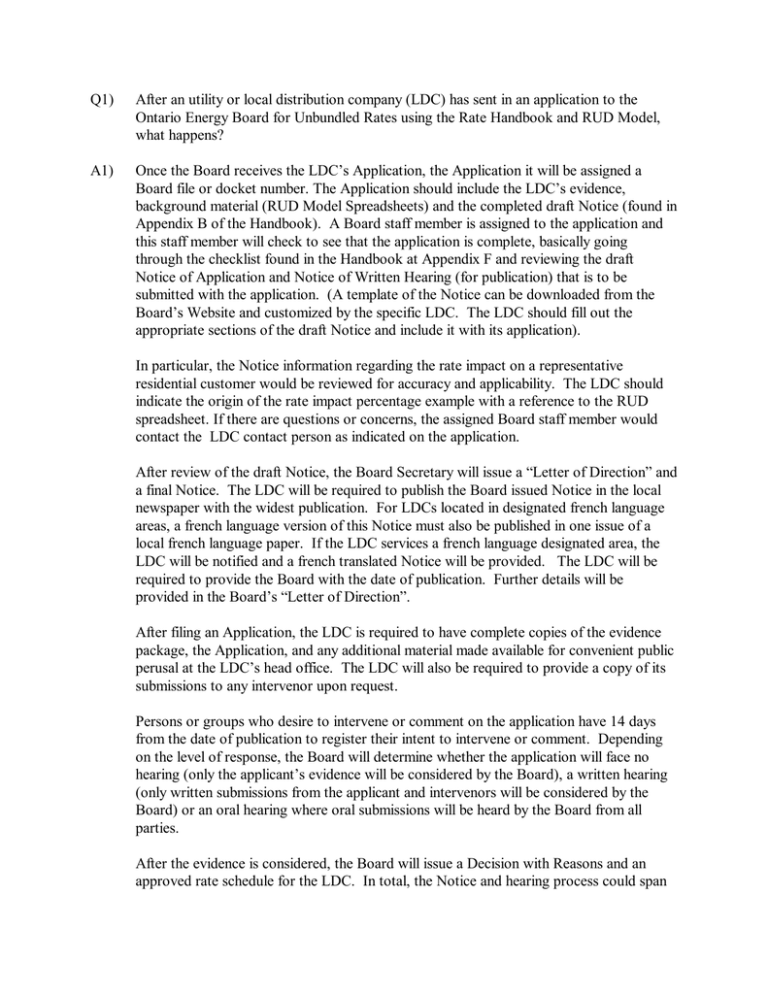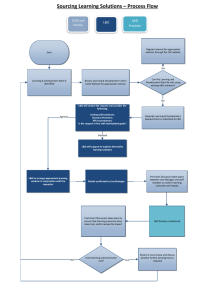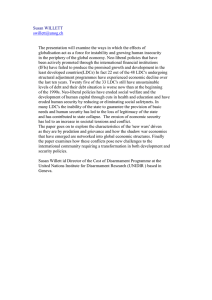Q1) After an utility or local distribution company (LDC) has sent in an
advertisement

Q1) After an utility or local distribution company (LDC) has sent in an application to the Ontario Energy Board for Unbundled Rates using the Rate Handbook and RUD Model, what happens? A1) Once the Board receives the LDC’s Application, the Application it will be assigned a Board file or docket number. The Application should include the LDC’s evidence, background material (RUD Model Spreadsheets) and the completed draft Notice (found in Appendix B of the Handbook). A Board staff member is assigned to the application and this staff member will check to see that the application is complete, basically going through the checklist found in the Handbook at Appendix F and reviewing the draft Notice of Application and Notice of Written Hearing (for publication) that is to be submitted with the application. (A template of the Notice can be downloaded from the Board’s Website and customized by the specific LDC. The LDC should fill out the appropriate sections of the draft Notice and include it with its application). In particular, the Notice information regarding the rate impact on a representative residential customer would be reviewed for accuracy and applicability. The LDC should indicate the origin of the rate impact percentage example with a reference to the RUD spreadsheet. If there are questions or concerns, the assigned Board staff member would contact the LDC contact person as indicated on the application. After review of the draft Notice, the Board Secretary will issue a “Letter of Direction” and a final Notice. The LDC will be required to publish the Board issued Notice in the local newspaper with the widest publication. For LDCs located in designated french language areas, a french language version of this Notice must also be published in one issue of a local french language paper. If the LDC services a french language designated area, the LDC will be notified and a french translated Notice will be provided. The LDC will be required to provide the Board with the date of publication. Further details will be provided in the Board’s “Letter of Direction”. After filing an Application, the LDC is required to have complete copies of the evidence package, the Application, and any additional material made available for convenient public perusal at the LDC’s head office. The LDC will also be required to provide a copy of its submissions to any intervenor upon request. Persons or groups who desire to intervene or comment on the application have 14 days from the date of publication to register their intent to intervene or comment. Depending on the level of response, the Board will determine whether the application will face no hearing (only the applicant’s evidence will be considered by the Board), a written hearing (only written submissions from the applicant and intervenors will be considered by the Board) or an oral hearing where oral submissions will be heard by the Board from all parties. After the evidence is considered, the Board will issue a Decision with Reasons and an approved rate schedule for the LDC. In total, the Notice and hearing process could span anywhere from 8 to 12 weeks depending on the number of interventions, the time frame for publication of the Notice, complexity of the Application, and/or whether an oral hearing is held. Q2) If an LDC owns assets that have been designated as transmission assets (ie, over 50kv) how should these assets be treated in the rate base for determining unbundled rates? A2) As indicated in Appendix D, Page 13 of the Rate Handbook, these assets should be included in the net fixed asset calculation and included in Table A3 under “Other amounts not listed above”as applicable. The methodology and reasons should be clearly documented and made available for the Board’s review when the application is filed. Q3) In the Rate Handbook, 1999 returns are subtracted from the Year 2000 MARR in calculating the additional revenue required to move to a target return. (See formula 3-3 on page 3-8). 1999 returns are calculated as: (1999 Rate Base x ROE 1999). Utilities with a negative ROE in 1999, however, will be subject to a "floor value" of 0 percent. This 0 percent floor appears to disadvantage utilities who earned a negative return in 1999. With no change in costs or sales volumes, they will be unable to reach the 9.88 return target? A3) The Rate Handbook indicates that negative returns in 1999 cannot be made up in the future. The adjustment for a higher return results in increased rates. Therefore, they are not disadvantaged by their current return levels. The Board's Decision (RP-1999-0034) indicates that utilities are expected to give due consideration to any rate increases resulting from their choice to move to a higher ROR. To address this concern the Board expects utilities to use the option of using a deferral account to phase in the earning of a utility's target ROR over several years to mitigate rate impact. Q4) If a customer’s load is only >50 kW several months in the year is this customer considered a >50 kW or <50 kW customer for the purposes of the Rate Handbook? A4) As long as the customer hits 50 kW in any month of the year, that customer is considered to be in the > 50 kW group as the capacity reserved for this customer on the system would need to be >50 kW. Q5) If a utility does not wish to go for the maximum ROE or chooses to remain at existing return level, do they have to go to the OEB to get their rates approved? A5) Yes, all electric utilities must come before the Board to get their unbundled rates approved and to initiate their PBR plan. There are no exceptions to this requirement. Q6) How does the rate impact mitigation mechanism work with the use of the deferral account? If a deferral account is used, does the amount in the account earn interest? A6) The following example illustrates the deferral mechanism: In the first year A utility has selected a Rate of Return of 9.0%. The additional revenue requirement to allow the utility to earn the selected Rate of Return is $15 million. If the utility tries to collect the full $15 million in the first year, it finds the rate impact to be excessive. Hence, the utility proposes to recover through rates only $10 million in the first year and the remaining $5 million is recorded in the deferral account 1574. In the second year In the second year, the utility’s rate will increase to recover the entire $15 million revenue requirement implied by the 9.0% Rate of Return (subject to the Board’s review of rate impact). Moreover, the utility is allowed (again, subject to the Board’s review of rate impact) to recover the $5 million recorded in the first year in the deferral account 1574 through the Z factor in the rate adjustment mechanism. Yes, the amount in the account does earn interest. The amount of interest accrued and paid on the $5 million deferred revenue requirement in account 1574 is subject to the policies and procedures set out in the Accounting Procedures Handbook for Electric Distribution Utilities. These will be provided to all LDCs in due course. Q7) How is the diversity credit for Large Users of an MEU treated in the RUD model? A7) The Diversity Credit, which is a form of subsidy, will cease to exist upon market opening. The credit does appear in RUD model as applicable to rates set before market opening but not for rates to be applied after market opening. However, after market opening, a large use customer has the option of buying from the competitive market. In the competitive market place, commodity prices may be equal or less than previous prices that included the diversity credit. Large User rates that are approved through the RUD model before market opening include the diversity adjustment. The diversity credit appears as a separate line item under Miscellaneous items. Upon market opening, the credit would no longer appear in Large User rates. Q8) When using the RUD model and testing for the impact of the rate structure change, is the 10% impact guideline to be used for each class? And, if the impact is over 10% for a certain rate class, can the service charge be reduced to zero to mitigate the rate impact? If the impact is less than 10% in the initial analysis, can an LDC still adjust the service charge? A8) The test for the rate impact of the rate structure change is to be used for each rate class and each class should have its rate impact evaluated separately. When adjusting the rate structure proportions to mitigate rate shock, the service charge should never be reduced to zero as the Board Decision (RP-1999-0034) indicates that the rate structure is mandated to include a service charge and a volumetric rate. If the impact on the initial analysis passes the guideline test (ie, is about 10% or less), the LDC may still adjust the rate structure components, as long as the Incremental Distribution Rate (IDC) is at least 0.0062 cents/kWh. However, utilities where existing rates are low may need to go below 0.0062 cents/kWh to achieve a viable two part rate structure. If this is the case, it should be highlighted in the Manager’s Summary as a deviation from the norm. Q9) How are distribution rates for General Service TOU customers determined if the LDC’s TOU rate design does not fit the RUD model methodology? A9) Ideally, when determining rates for General Service TOU customers, an LDC would remove the Cost of Power for the TOU customers, leaving the distribution rates that are the same for the TOU and non-TOU General Service customers. In some cases, due to peculiar rate design in the past, it could appear that there is a costbasis for a difference in the TOU and non-TOU GS Rates other than the incremental cost for the time of use metering. In this case, the LDC should remove the COP from the TOU revenue requirement, take the TOU distribution Revenue Requirement, add it to the nonTOU distribution Revenue Requirement, and then divide by total GS (>50 kW) number of customers (i.e. both non-TOU and TOU customers). Remember to remove the Revenue Requirement for the incremental TOU metering cost and add this as a line item for the TOU customers. Then the LDC can continue developing distribution rates using the RUD spreadsheet. Any adjustment of this type should be highlighted as a change to the standard unbundling model as part of the Manager's summary. Q10) The Draft Rate Handbook used the term "effective tax rate" in the formula for the MBRR adjustment. Is there some significance to the change in terminology to "deemed tax rate" in the new Rates Handbook? A10) The Draft Rate Handbook included the word "effective" because it was a place holder. With the finalization of the Rate Handbook the Board has established that the tax should be the “deemed” amount. Reconciliation with actual tax levels is not required. Q11) If an LDC has acquired some service territory from OHNC-Distribution over the past year, how should the LDC treat this when applying the rate handbook/RUD model? A11) The LDC should prorate their 1999 results to account for the additional service territory/customers that were acquired in that year. Q12) How are the Sensitivity Analysis sheets used? A12) The “Sensitivity Analysis 1" sheet is designed to assist LDCs in adjusting the restructured (unbundled) rates to mitigate the rate impact of the new rate structure if it exceeds 10% for low-end customers within each class. The RUD model requires the LDC to input a proportion for variable and service charge revenue. You must enter the proportions that pertain to your utility, not necessarily the 40 - 60 split that is currently entered on the sheet (those values are for illustrative purposes only). Utility proportions can be obtained by looking at any of the classes (other than residential) on the “Revenue Reqts and Distr. Charges” sheet under the section “to calculate variable and service charge revenue”. A table showing distribution revenue, variable revenue and service charge revenue for residential class (eg. Line 118) appears. On the next line (line 119) revenue share numbers are shown. These are the numbers that should be entered on the “Sensitivity Analysis 1" sheet on the chosen revenue shares line for each class. These numbers are the starting point for the analysis. The sheet compares the total bill under restructuring with the total bill under existing rates and provides the impact for a number of consumption levels within each class. Consumption levels can be adjusted to fit specific utility profiles. The variable revenue proportion can be moved upwards (the service charge proportion automatically decreases) as much as necessary to reduce the impact on low consumption customers. However, the variable revenue portion cannot go below the starting level. The final level chosen for the variable revenue and service charge proportions must be the same for all consumption levels within a class, but can differ across classes. Changes to the “Sensitivity Analysis 2" and “Sensitivity Analysis 3" sheets are not required unless consumption levels were changed on the “Sensitivity Analysis 1“ sheet. In this case, the same consumption level changes should be made to the latter sheets. Q13) How does an LDC deal with unbilled revenue? A13) The retail energy numbers required by the RUD model should include a full 12 months data. If, for example, energy consumed in December of 1999 that wasn’t billed until January 2000 should be included in 1999 sales data if December 1998 sales that were billed in January 1999 were included in 1998. To include unbilled amounts, the amount that belongs in each rate class block should be estimated and added to the respective amounts for regularly billed sales.

